Above: Channel 7 coverage of attorney Nabih Ayad’s disclosure that Detroit cop Darrel Fitzgerald’s deposition showed Terrance Kellom had no hammer
Blue wall of silence stands: Fitzgerald reverses testimony third time during civil trial, claims he did not see Kellom with OR without a hammer, did see hammer in house after he left and returned
Most of civil trial proceedings held through motions ‘in limine’ held in Judge Sean Cox’s chambers out of public view
By Diane Bukowski
December 3, 2019
REVISED FROM DEC. 2 STORY AFTER VOD REVIEWED FITZGERALD’S TESTIMONY AT COURTHOUSE, ONLY MEANS ALLOWED BY JUDGE COX
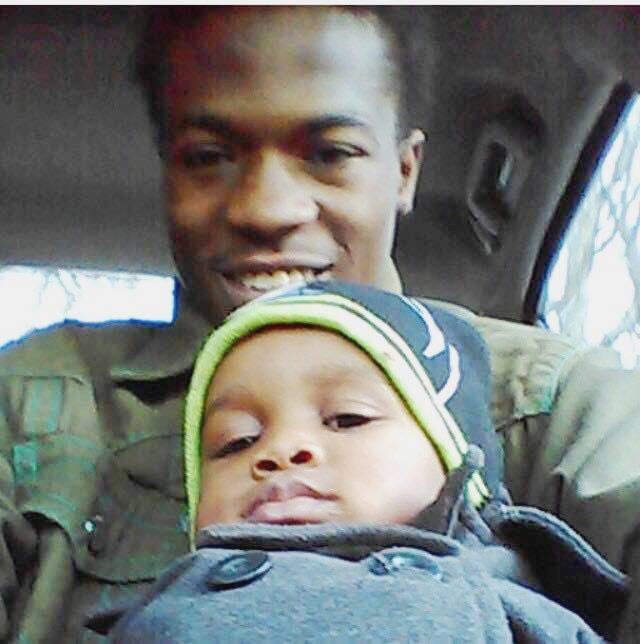
Terrance Kellom, 19, with baby son. He was expecting the imminent birth of his daughter. Facebook
DETROIT — The news that a federal civil jury rendered a verdict of “no cause” Nov. 4 after deliberating for three hours, on a lawsuit against the 2015 death of 19-year-old Detroit dad Terrance Kellom at the hands of I.C.E. agent Mitchell Quinn and a police task force, has devastated his family and shocked many community members.
“Y’all took my son away from me, his kids, and our family!” his father Kevin Kellom commented on his Facebook page. “Y’all then lied on him in court, and a biased judge allowed y’all to get away with murdering my son in me and my daughter (Teria Kellom)’s face. I want y’all to understand, justice will be served, by hook or crook, you still have to deal with karma and there is no biased judge or jury in her courtroom. Everybody has to answer to God!!”
The family’s attorney Nabih Ayad said he plans to appeal the case.
A “Detroit Fugitive Apprehension Team” (D-FAT) stormed Kellom’s home without a search warrant to arrest his son Terrance on an outstanding armed robbery warrant April 27, 2015. The police had seen both Kelloms outside just prior to the home invasion and could have enforced the warrant in public view.
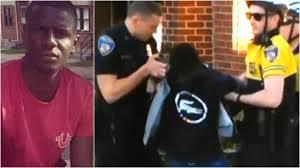
Freddie Gray during his arrest.
Former Detroit police officer Mitchell Quinn, deputized as a federal I.C.E. agent, and possibly other Detroit officers, unexpectedly opened fire on an unarmed Kellom in a living room hallway, killing him with at least four gunshots, as he cried out, “Dad, Dad!,” according to family eyewitnesses.
In the next days, masses of “Black Lives Matters” protesters occupied Evergreen outside the family home and marched down Joy Road. Simultaneously, Baltimore was in chaos, even forced to cancel a Major League game, as protesters rose up for days against the police killing of Freddie Gray.
Contradicting the family’s version, police and later Wayne County Prosecutor Kym Worthy claimed Kellom was wielding a hammer, swinging it over his head as he ran at Quinn.
However, In her press conference, held months after the killing, Worthy admitted that no fingerprints were found on the hammer. Earlier, she sealed the Medical Examiner’s report on Kellom’s death from public view until the press conference. That report showed that Kellom had indeed been shot in the back, likely as he was lying on the floor because the bullet did not exit his chest. Worthy claimed the bullet hole resulted from Kellom “turning slightly to the right.”
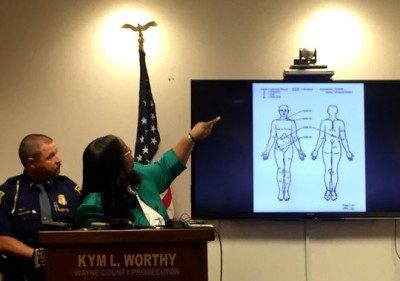
Pros. Kym Worthy press conference on Kellom killing.
Kellom family supporters had been expecting that Detroit Police Sgt. Darrel Fitzgerald would testify that Kellom was NOT armed with a hammer as Fitzgerald said in his sworn deposition taken by plaintiff’s attorney Nabih Ayad. Fitzgerald earlier wrote directly after the killing that Kellom was “holding a hammer over his head and advancing on Quinn” when he was gunned down.
The mainstream media covered Ayad’s announcement of Fitzgerald’s recantation extensively and internationally. Wayne County Prosecutor Kym Worthy and Michigan Attorney General Dana Nessel said they would re-open their investigations into the case.
But Fitzgerald reversed his testimony during the trial a THIRD time, swearing Oct. 24 that he did not see Kellom at all, either with or without a hammer, as he was shot to death.
 Fitzgerald, the Detroit officer in charge of Kellom’s outstanding armed robbery warrant, said Agent Quinn and Kevin Kellom began running upstairs after Fitzgerald heard an officer there shout, “Put the hammer down, I’m not going to shoot you.”
Fitzgerald, the Detroit officer in charge of Kellom’s outstanding armed robbery warrant, said Agent Quinn and Kevin Kellom began running upstairs after Fitzgerald heard an officer there shout, “Put the hammer down, I’m not going to shoot you.”
In the ensuing chaos, he testified, gunshots rang out in the first floor hallway, but he could not see Terrance Kellom AT ALL during the confrontation, despite standing directly nearby.
Fitzgerald also reversed his sworn deposition testimony that he saw no hammer in the house at all. He claimed instead that he left the house shortly after the shooting, and saw a hammer when he came back. Forensics testing showed that hammer had no fingerprints on it.
His testimony is currently only available by viewing it on the U.S. Federal Courthouse terminal directly, with no copies allowed by Cox until Jan. 29, 2020.
Matthew Schneider of the U.S. Attorney’s Office in Detroit issued the following release on the federal jury verdict, headlined “Federal Agent Cleared of Wrongdoing in Death of Fugitive:”
“After a two-week trial, an eight-member jury found defendant Mitchell Quinn, deputized at the time as a U.S. Marshals task force officer, did not violate the constitutional rights of Terrance Kellom, a felon who was wanted on an arrest warrant for armed robbery, among other offenses. The jury deliberated less than three hours before returning their verdict of no cause.
“According to the evidence presented at trial, agent Quinn acted in self-defense when Terrence Kellom attacked him with a hammer during the attempted arrest of Mr. Kellom on April 27, 2015.”
In addition to the serious setback represented by officer Fitzgerald’s reversal of his deposition testimony, VOD’s research of court documents shows that U.S. District Court Judge Sean Cox used his gavel to hammer most of the plaintiff’s evidence and arguments out of the trial, preventing the jury from ever hearing them. He held numerous in limine (non-public) hearings, then issued an order Sept. 4, 2019 upholding most of the defendant United States of America’s arguments. See 31 page protective order at http://voiceofdetroit.net/wp-content/uploads/Cox-order-Kellom-case-pages-deleted.pdf.
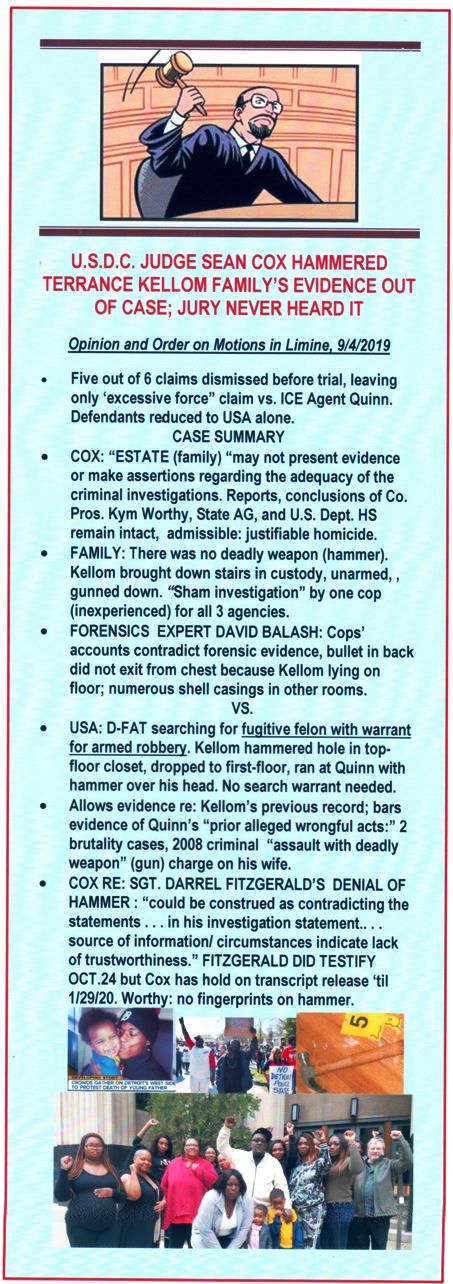 Cox ruled that “plaintiffs “may not present evidence or make assertions regarding the adequacy of the criminal investigations.” He referred to reports and conclusions by Wayne County Prosecutor Kym Worthy, the State Police, and the U.S. Department of Homeland Security. In other words, their conclusions of “justifiable homicide” remained intact and admissible.
Cox ruled that “plaintiffs “may not present evidence or make assertions regarding the adequacy of the criminal investigations.” He referred to reports and conclusions by Wayne County Prosecutor Kym Worthy, the State Police, and the U.S. Department of Homeland Security. In other words, their conclusions of “justifiable homicide” remained intact and admissible.
In addition, Judge Cox wielded a heavy hammer against Attorney Ayad and Kevin Kellom in response to Ayad’s disclosure of the plaintiff’s own sworn deposition of Officer Fitzgerald.
Judge Cox ruled that Ayad had violated an April 23, 2018 “Stipulated Protective Order” and ordered him to pay $2,220 to Quinn’s attorneys.
A story by Detroit News reporter George Hunter called the original order a “gag order,” which “barred anyone involved in the lawsuit from discussing the case.” Hunter said both plaintiffs and defense had agreed to that order.
The actual order, however, falls far short of Hunter’s description.
The filing opens with the following wording, “This Protective Order shall govern the production and disclosure of any documents, electronically stored information, materials, things, discovery material (including responses to interrogatories, depositions, and requests to admit), materials filed with the Court, or testimony in this action.”
But it goes on to state without reservation, “This order permits Officer Mitchell Quinn and the pertinent federal agencies, such as the United States Department of Homeland Security, its Office of Inspector General, United States Immigration and Customs Enforcement, and the United States Marshals Service, and other agencies, to disclose information regarding Terrence Kellom and Officer Quinn.”
Regarding Kellom’s family and their attorneys, the order says, “Plaintiff, her counsel, and other parties shall not disclose any of the records or information to any person unless the disclosure is reasonably and in good faith calculated to aid in the preparation and/or prosecution of this case. Such records shall be maintained in strict confidence by all parties. Plaintiff, her counsel, and all parties are prohibited from copying such records or disclosing or discussing their contents, except as is necessary for purposes of this litigation.”
In fact, Ayad did not provide actual copies of Fitzgerald’s deposition during his press conferences regarding Fitzgerald’s disclosure that Terrance Kellom did not have a hammer and that he did not see any hammer in the house. This reporter tried to find a copy of the actual deposition in on-line court documents, but was unable to do so.
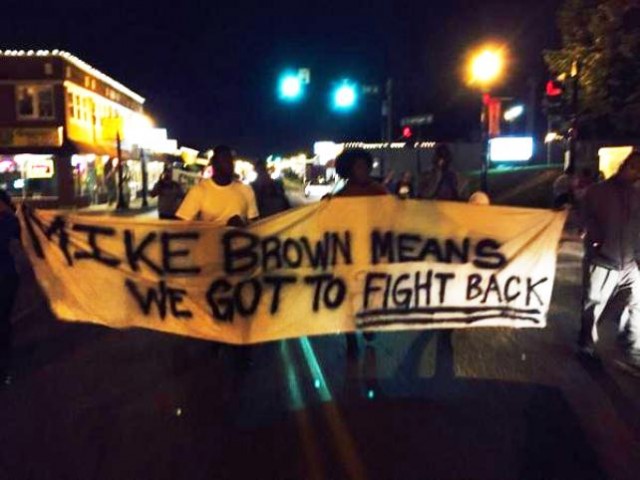
Protest after brutal killing of 18-year-old Michael Brown in Ferguson, MO
It is certainly arguable that the public had a right to know about Fitzgerald’s disclosure of events he witnessed on April 27, 2015, in the midst of the national “Black Lives Matter” movement. The Detroit Fugitive Apprehension Team killed Kellom just after Baltimore police killed Freddie Gray, an event that led to widespread uprisings throughout Baltimore and the nation. Those uprisings followed numerous others that began with the murder of Michael Brown in Ferguson, Missouri in 2014. Virtually no law enforcement agents have been indicted, charged or sentenced for any of the hundreds of murders.
Even the U.S. Department of Justice, which is playing a heavy-handed role in the Kellom case, refused to find civil rights violations in most of those cases.
The remainder of the order comes perilously close to concealing court records from public view in violation of both state and federal laws, just as Judge Cox is concealing the transcripts of Officer Fitzgerald’s testimony at the trial.
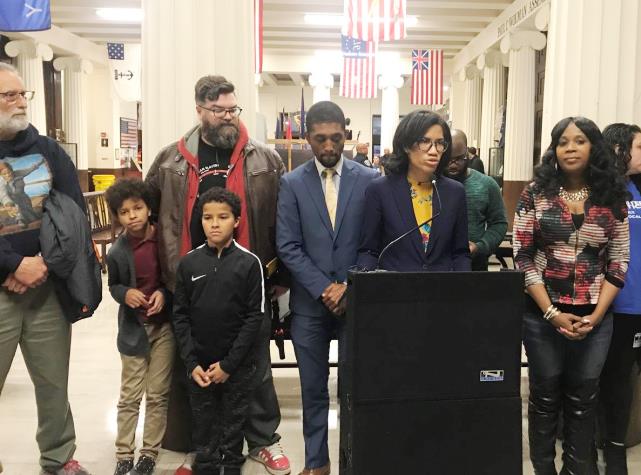
Baltimore Councilwoman Shannon Sneed announces the passage of bill banning gag orders, accompanied by Council Pres. Brandon Scott (l) and activist Tawanda Jones (r).
There is a movement against gag orders, particularly in police brutality cases, growing across the nation.
According to WYPR 88.1 FM radio, “The Baltimore City Council passed a bill Oct. 27 that bans the use of gag orders in the settlements of all police brutality and discrimination cases and bolsters transparency throughout the city’s litigation system.”
“The bill, titled Transparency and Oversight in Claims and Litigation, was introduced by Councilwoman Shannon Sneed and City Council President Brandon Scott in July. Dozens of city residents testified before the council in a September hearing about their experiences with gag orders in lawsuit settlements, calling them “hush money” and “abusive.”
“Tawanda Jones, an activist whose brother was murdered by police six years ago, called the bill a huge victory.
“This is the moment we’ve been waiting for,” Jones said. “I had to take my name off of my brother’s settlement because I refused to be silent. At the end of the day, forced silence condones police violence.”
The Reporters Committee for Freedom of the Press in 2017 said, “Communications service providers are constantly faced with demands to turn over their customer’s records to law enforcement. But Microsoft found that when it was served with these demands, they were all too often accompanied by gag orders with no ending date, forbidding them to talk about the demand or tell their customer that their records were involved. So the tech giant decided last year to sue the government over those gag orders in federal court in Seattle, and in February, it overcame the first hurdle by beating back the government’s effort to have that part of the case dismissed.\
***********************************************************************************
Brother C.J. Airs Video for Aiyana Jones, 7, killed by cops
Yana world cj – letter to aiyana
(Official Video)
Shot by @Dodbh
The video above was released by Aiyana Stanley-Jones’ younger brother Christian Jones, who was in the house as a toddler when a Detroit police task force shot his sister, aged 7, to death May 16, 2010, as she lay sleeping with her grandmother Mertilla Jones.
The Wayne County Prosecutor’s Office relented somewhat in Jones’ case with a civil settlement and reduction of Aiyana’s father’s sentence, but Prosecutor Kym Worthy worked hard to defeat civil lawsuit Nov. 4 for unarmed Terrence Kellom, 19, killed by police DPD/I.C.E. task force in 2015.

Aiyana Jones and little brother light Christmas tree before her vicious murder in 2010
November 21, 2019

Editorial
By Diane Bukowski
Detroit--News aired today over all stations that Detroit police officer Rasheen McClain was killed after entering a Detroit home where a yet unidentified man allegedly had threatened members of a family with a high-speed rifle. Detroit Mayor Mike Duggan and Police Chief James Craig were there afterwards, along with hundreds of police standing vigil at Sinai-Grace Hospital. If the alleged killer is charged and convicted, his life will likely end in prison.
In contrast, after a Detroit police SWAT team led by an armored truck and police in military gear with machine guns shot 7-year-old Aiyana Jones in the head to death May 16, 2010, her large family and neighbors held an agonized vigil outside her home. They called on then Mayor Dave Bing and Police Chief Warren Evans to speak to them. The two never came to that vigil. They never apologized to the family for the horrific raid, during which Officer Joseph Weekley, Jr. fired his gun within seconds after kicking the door down, directly into the child’s head, possibly at contact range according to Wayne County Medical Examiner Carl Schmidt.
The other day, I visited with Mertilla “Maria” Jones, Aiyana’s grandmother, who was sleeping with her during her vicious murder by police. Mrs. Jonese is still grieving and in poor health. She told me that after nearly ten years she still has flashbacks of watching her beloved grandchild’s head blown off by Weekley’s MP-5 automatic submachine gun. Members of the police team then snatched up Aiyana and ran with her out of the house before the family had any chance to touch and console her as she lay dying. Aiyana was the oldest child of Charles Jones, who with her mother Dominika Stanley and two toddler brothers were all in the home at the time. Also present were Mertilla Jones’ sister and two male relatives.

Killer cop Joseph Weekley as star on previous A&E DETROIT SWAT website.
The police forced Charles Jones to crawl out of a back bedroom, where he was sleeping with Aiyana’s mother Dominika and their two toddlers, over blood-stained glass and pieces of Aiyana’s brain, then forced him and the other occupants to sit on the blood-stained couch where Aiyana died.
After several mistrials for “manslaughter,” Weekley walked out a free man while Aiyana’s dad Charles Jones was falsely charged in the murder of Je’Rean Blake, 17, two days earlier outside a neighborhood liquor store. Despite the mainstream media’s constant assertion that Charles gave his brother–in-law Chauncey Owens the gun to kill Blake, a police video at the trial of the two men showed Chauncey naming another individual who provided the gun, not Charles.
Charles was finally re-sentenced to a charge of manslaughter, reduced from second-degree murder, to run concurrently with a 10-year sentence for perjury. He will face the parole board finally in 2021, and his attorney has pledged to be there to support him. Charles had been expecting to serve 40-60 years. He pled “nolo contendere” to the charges, meaning he would be shielded from civil liability. The action came as a result of appeals by his attorney, not as a “gift” from Prosecutor Kym Worthy, known nationally as an “Innocence Denier” due to her refusal to admit that 14-year-old Davontae Sanford was innocent of the four Runyon Street murders
Video below: community asks where Police Chief and Mayor are the night after Aiyana’s death, during a candlelight vigil.
Meanwhile, Ms. Jones told me, her family has flourished, with her own eight children producing 50 grand and great-grandchildren. Aiyana’s brother Christian Jones, known as C.J., recently released the militant video at the top of the story about his older sister’s death and his continuing grief and longing for her. He was accompanied by some of Aiyana’s other relatives at her gravesite.
Wayne County Prosecutor and the City of Detroit, after viciously pursuing the victim’s family, constantly harassing and arresting her aunts and uncles for many years aferwards, finally relented to some degree, approving an $8.2 million lawsuit settlement in her death, filed by Attorney Geoffrey Fieger. In the video, Christian vows to use the money to assist others. It is published on his Facebook page, yanaworldcj.
RELATED STORIES:
#JailKillerKops, #Justice4TerranceKellom, #Justice4AiyanaJones, #Justice4AdaishaMiller, #Justice4KimoniDavis, #DownwithPoliceState




